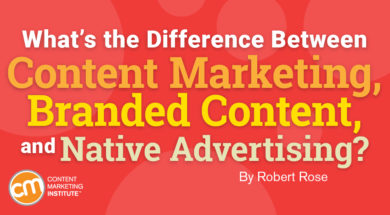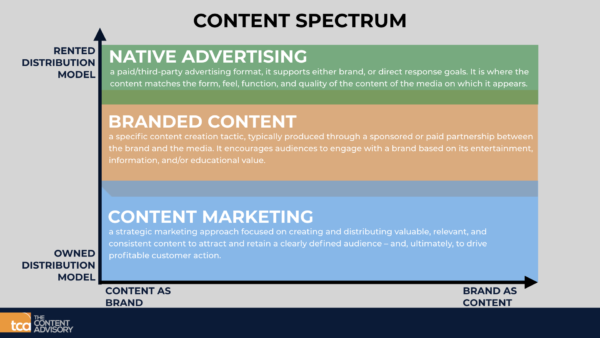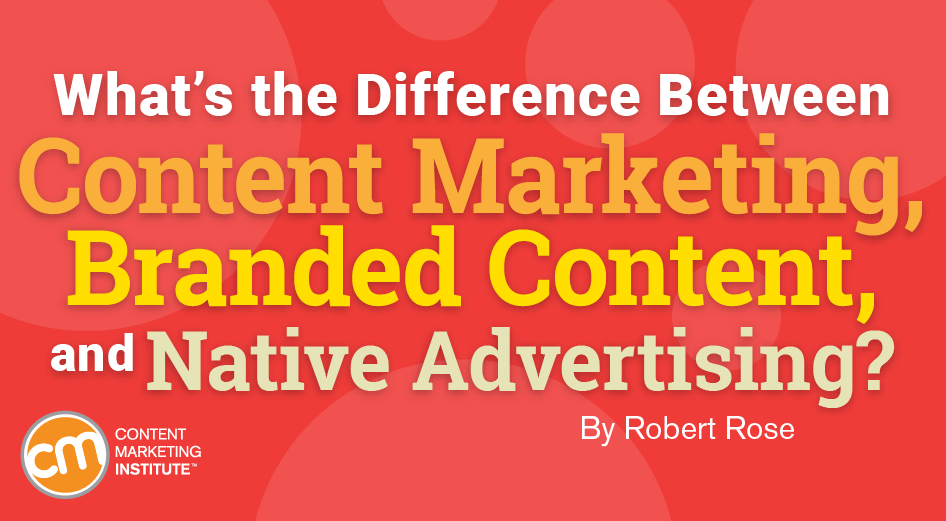
Two of the most frequent questions I’m asked about a new content publication project are: “How much of our brand should be in our content?” and “What should the distribution model be?”
Three years ago, I wrote an article, Clarifying the Noise: The Content Marketing Spectrum. I attempted to stratify (and demystify a bit) the different approaches of content marketing, native advertising, and branded content. At the time, I said this was a “work in progress” and I would add to it as we thought of new ways to provide clarity.
Well, here we are in 2019 and a couple of hundred workshops, consulting assignments, and advisories later, we have a better handle on it. Now is the time to clarify the differences. But, perhaps the more relevant question today is:
Does it matter what we call it?
Maybe it doesn’t. As we’ve said, labeling an approach to content marketing isn’t as necessary as ensuring that the activities are a meaningful part of the brand’s integrated marketing mix. However, one observation we’ve made is that, when done well, each of these practices can be optimized to address the different parts of the engagement journey.
Answering those two common questions I mentioned aside, understanding – and being able to explain – the differences among content marketing, branded content, and native advertising can help you accomplish two things:
Knowing #contentmarketing, #brandedcontent, #nativeadvertising increases chance of success. @Robert_Rose Click To Tweet- Make a more solid business case for doing one practice – especially when asking for budget (or permission) from a part of the organization that has a bias for one over the other.
- Optimize the chance for success given the natural tendency for the different approaches to better support different types of goals. (For example, a branded content campaign that prominently features the brand may better support a short-term lift in brand loyalty. While a content marketing initiative – a content brand – may be more effective at driving awareness for an old, traditional brand introducing a new, disruptive way of doing business.)
Just as different types of advertising content support different business goals (e.g., brand advertising, direct response advertising), so too can each content approach better support different business goals.
Put simply, knowing the differences can help you be more successful at any one of them.
2 differentiating questions
I start the definitions by looking at the two frequently asked questions.
1. How much of the existing brand should we include in our content?
This comes down to a spectrum – content-as-brand vs. brand-as-content. With content-as-brand, content is a separate product, unbranded, and sometimes disassociated from your products. On the other extreme – brand-as-content – content is an extension of the existing product or brand.
Put simply, at one end of the spectrum the brand isn’t mentioned and at the other end the content is all about celebrating the brand. Examples include:
- Content-as-brand – Johnson & Johnson’s Babycenter.com
- Brand-as-content – Salesforce’s Dreamforce
2. What distribution model should we use for our content?
The question really is about how you get your content in front of audiences. This answer also covers a spectrum. At one end are your owned media distribution channels. At the other end are rented media distribution channels.
Look beyond the money being exchanged (or not) and consider distribution ownership from a control perspective. To plot along this rent-vs.-own spectrum, ask how much you depend (paid or otherwise) on a third party to distribute and engage an audience with your content. These partnerships may come in the form of earned relationships through social media or even distribution through partnerships with movie theaters, television networks, or feature film studios.
How much do you depend on a third party to distribute your #content to its audience, asks @Robert_Rose. Click To TweetDefining the approaches: The 2020 Content Spectrum
Using these two questions as the basis for the x and y axes, the stratification for content marketing, branded content/entertainment, and native advertising can be plotted.

Native advertising
The classic term for native advertising is advertorial – an advertisement in a newspaper or magazine appears in the style of an editorial or journalistic article. With the rise in digital media, this idea has expanded. Jesper Laursen, CEO of the Native Advertising Institute, has a wonderful definition. He says native advertising is “paid advertising where the format of the content matches the form, feel, function, and quality of the content of the media on which it appears.”
Now, this helps us understand where native advertising sits on the Y axis, but what about the X axis? What goals will it support?
CMI take
We add a short prelude to Jesper’s definition:
Native advertising is a paid/third-party advertising format that supports either brand or direct-response goals, and is where the content matches the form, feel, function, and quality of the content of the media on which it appears.
Branded content
In their book, The Definitive Guide to Strategic Content Marketing, authors Lazar Dzamic and Justin Kirby point to a Branded Content Marketing Association definition. Branded content is content that is “funded or at least endorsed by the legal owner of the brand that promotes the owner’s brand values, and makes audiences choose to engage with the brand based on a pull logic due to its entertainment, information, and/or education value.”
CMI take
While we like that definition – we simplify it and add a prelude about the dimension of business goals.
Branded content is a content creation tactic, typically produced through a sponsored or paid partnership between the brand and the media, that encourages audiences to engage with the brand based on its entertainment, information, and/or educational value.
Content marketing
Here we stick with the definition we have used for years that speaks to the foundational aspect of brand-as-media-company, the owned distribution model, and the strategic business focus and purpose of engaging and building audiences.
CMI take
Content marketing is a strategic marketing approach focused on creating and distributing valuable, relevant, and consistent content to attract and retain a clearly defined audience – and, ultimately, to drive profitable customer action.
Stacked spectrum of strategic content
As you put together all these things, you can see the kinds of content and where you may want to think about content brands, the distribution model, and aligning them with specific business goals.
To help put all of this into context, we created a new version of our content spectrum video – walking through the elements discussed above and providing examples of content that fits into each segmented space.
We hope this understanding can help you make your business case for a content marketing platform, a branded content initiative, a native advertising campaign, or something in between.
Expand your knowledge and skills around native advertising, branded content, or content marketing at Content Marketing World Sept. 2-6 in Cleveland, Ohio. Register today and use code BLOG100 to save $100.
Cover image by Joseph Kalinowski/Content Marketing Institute

